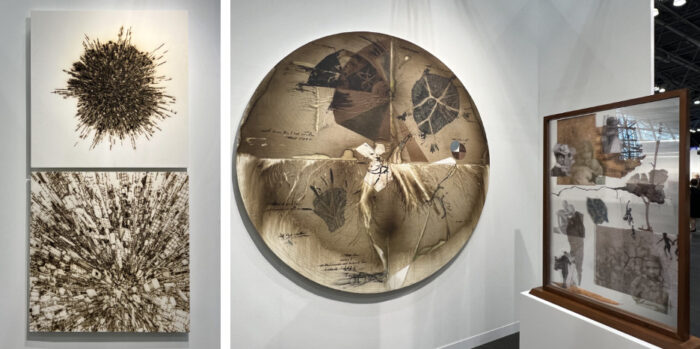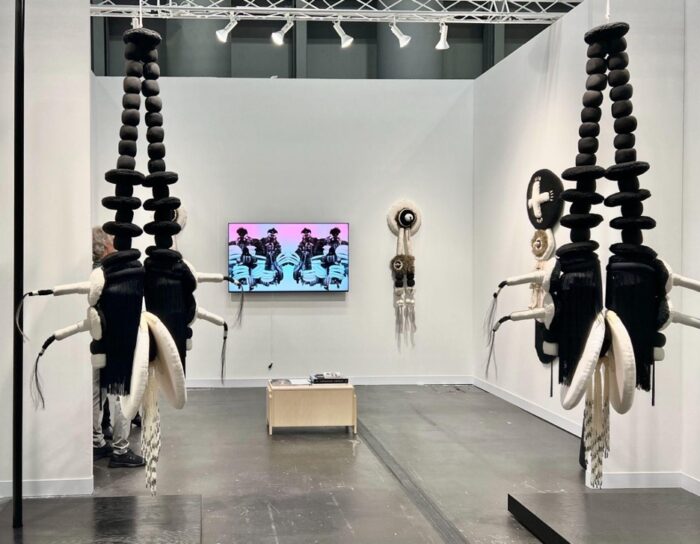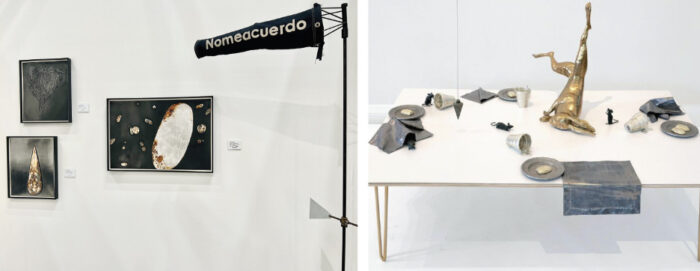Please subscribe here to our YouTube channel to see more shows.
Southern Guild (Booth 345; Cape Town and Los Angeles)
Presenting work by Zizipho Poswa, Kamyar Bineshtarigh, Manyaku Mashilo, and Oluseye

There is something warm and monumental about the cohort of artworks at Southern Guild. Walking into the booth feels like an immersive experience in a world of material tactility, communal kinship, and spirituality. With an extremely striking body of work, the Iranian-born, South-Africa-based artist Kamyar Bineshtarigh explores the process of mark-making—intentional and unintentional alike—by painting on, peeling off, and preserving the walls of his studio, which was formerly a clothing factory. A wide range of media superimpose onto each other: ink, paint, and cold glue as if to document the evidence of living and existing. In each piece, there are so many layers to look at. Seeing them on the pristine walls of the international art fair serves as a further reminder of displacement and migration, both of which are central to the artist’s creative odyssey.
Manyaku Mashilo’s multimedia paintings captivate the viewer with an exploration of duality and temporality. The figures’ visages are imbued with emotional intimacy and depth. The free-flowing washes of ultramarine and vibrant orange are complicated by the delicacy of the curvilinear lines that are reminiscent of fabric patterns or even topographic lines.
Nature Morte (Booth 218; New Delhi)
Presenting work by Kamrooz Aram, Sagarika Sundaram, Jitish Kallat, Thukral and Tagra, Martand Khosla, Manisha Parekh, and Parul Gupta.

As the only gallery from India participating in the fair this year, Nature Morte shows artworks of a wide range of media, including Sagarika Sundaram’s Iris (2023) made with wool, or Jitish Kallat’s lenticular photo series, Epicycles (2022). Intertwining the contemporary with the historical, Kallat introduces his journals made during the 2020 pandemic to a selection of archival photos. The fabrication technique makes these images come and go, as one circumambulates the two-sided work.
A similar kind of optical destabilization is echoed by Martand Khosla’s Coda paintings (2023). With a background in architecture, Khosla executes these artworks on medium-density fireboard. The tiny, claustrophobic rectangles point to modernity’s explosive force and the rapid urban sprawl taking place in metropolitan cities. These energetic lines dash out of the epicenter of each painting to create an atlas of skyscrapers, ladders, and perhaps auto parts.
Public Gallery (Booth P13; London)
Presenting work by Cathrin Hoffmann

Extremely expressive and visually tenacious, the work of German-Iranian artist Cathrin Hoffmann tears the human body apart. Paying homage to the interwar lexicon of violence and terror, Hoffmann is inspired by artists such as George Grosz or Otto Dix, while also situating the work in the present-day context of an “anxiety-ridden existential quest.” She portrays eroticized human-like figures with exaggerated proportions and spasmic musculature. The paintings deploy an ominous color palette, combined with repeating motifs such as beaked masks, bodily fluids, and skin lesions. In clear distress and discomfort, the figures are haunted by the specters of death and disease that constantly overshadow them. They even ensured that the lights at the booth were placed so precisely that ghastly shadows appeared on the wall directly behind the two central sculptures. Simultaneously beautiful and nauseating, these pieces by Cathrin Hoffmann will pull you into a world of post-humanist apocalypse.
Bockley Gallery (Minneapolis) / STARS Gallery (Los Angeles); Booth F29
Presenting work by Eric-Paul Riege

Curated by Candice Hopkins, this year’s Focus section is titled Inheritances: material and otherwise to honor Indigenous traditions and to reclaim historical narratives in a contemporary setting. At Booth F29, which is co-presented by Bockley Gallery and STARS Gallery, Divé (Navajo) artist Eric-Paul Riege uses performance, video, and soft sculpture to imbue the room with a deep sense of veneration for the rituals and cultural heritage, which he gained exposure to through his mother. It is as if the sculptures, made with both natural and man-made materials, can breathe with the viewer. They are not only enlarged renderings of adornments but also the organic bodies of larger-than-life beings. Think about, perhaps, the sacred churro sheep. One must wonder: what kinds of stories are being weaved? With the artist embodying and moving with the soft sculptures in the video presentation, what does it mean for the younger generation to reinvent a dynamic set of cultural practices in dialogue with technology?
Dreamsong (Booth P34, Minneapolis)
Presenting work by David Goldes and Alexa Horochowski

Walking into the booth of Dreamsong, you are immediately surrounded by metals. With an avid interest in science, David Goldes originally made photographs of the process in which electricity would run through graphite on metal sheets until he discovered the obsolescent beauty of what is left behind. The burnt marks on the metal become permanent symbols of chance and disorder, hearkening back to the intellectual underpinnings of Ellsworth Kelly or John Cage. In a dialogue of materiality with Goldes, Minneapolis-based artist Alexa Horochowski monumentalizes her childhood picnic in Argentina by casting a still-life scene in metal. While the objects are still naturalistic in form, they are substantially transformed, just like how the handkerchief, supposedly soft, is now made of lead. Nomeacuerdo, a reference to María Elena Walsh’s El País del Nomeacuerdo, reflects the artist’s concern with the social causes and the political history of Argentina. Dreamsong’s booth shows how the two artists imbue the medium of metal with a broad range of interpretive possibilities.


